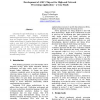Free Online Productivity Tools
i2Speak
i2Symbol
i2OCR
iTex2Img
iWeb2Print
iWeb2Shot
i2Type
iPdf2Split
iPdf2Merge
i2Bopomofo
i2Arabic
i2Style
i2Image
i2PDF
iLatex2Rtf
Sci2ools
VLSID
2002
IEEE
2002
IEEE
Development of ASIC Chip-Set for High-End Network Processing Application-A Case Study
Choosing the right methodology is a significant step towards successful VLSI designs. Traditional methodologies and tools are no longer adequate to handle large and complex designs. This paper presents a novel design methodology for complex deep-submicron designs, using a case study of the development of a high-end network processing ASIC chip-set. The paper focuses on the synergetic use of the "dual design verification approach", along with static verification methods in achieving defect free silicon. It also discusses the techniques employed for achieving faster and lessiterative timing closure.
Computer Architecture | Dual Design Verification | Static Verification Methods | Successful Vlsi Designs | VLSID 2002 |
| Added | 01 Dec 2009 |
| Updated | 01 Dec 2009 |
| Type | Conference |
| Year | 2002 |
| Where | VLSID |
| Authors | Sanjeev Patel |
Comments (0)

